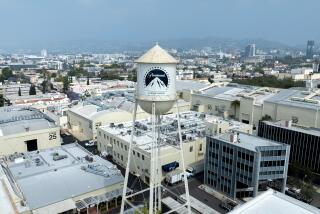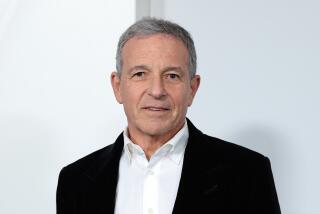Wells Played a Major Role in Disney’s Recent Turnaround : Entertainment: Eisner’s right-hand man helped build company’s market value from $2 billion to $22 billion.
Frank G. Wells was something of a corporate character actor, playing a critical role in Hollywood’s biggest turnaround but rarely getting the kind of star treatment accorded to Chairman Michael D. Eisner.
But the 62-year-old, unassuming Walt Disney Co. president and chief operating officer, who died in a helicopter crash on Sunday, was as much a part of Disney’s comeback in the 1980s as any of the company’s more recognized executives. Moreover, he was one of Hollywood’s most popular figures, as evidenced by the reaction late Sunday to his death.
“I’m in an incredible state of shock,” said entertainment executive David Geffen, a close friend of Wells’ for 25 years. “Not only was he a brilliant executive, he was an extremely honorable man. This is an incredible loss to the community.”
Said Jeffrey Berg, chairman of the International Creative Management talent agency: “This is an incomprehensible loss. I know of no one who so relentlessly pursued life’s callings and at the same time managed a brilliant career. Everyone will reflect upon his business success, when in fact his true devotion was to Luanne (his wife) and his kids.”
This September will mark the 10th anniversary since Eisner and Wells were tapped to effectively save an American icon that was in danger of being dismantled by a host of corporate raiders who saw profit in breaking it up. Wells and Eisner were one of the few stable executive teams in Hollywood.
Eisner and Wells had a rare working partnership, and industry executives say Wells will be difficult to replace.
“He behaved in the corporate world with an ethical standard unparalleled in my experience. I have lost a dear friend and my most treasured colleague,” Eisner said in a statement.
Wells was often overshadowed by the high-profile Eisner. The irony was that Eisner might not even have the job today had it not been for Wells.
The struggle for control of Disney in 1984 was engineered by investor Roy E. Disney, nephew of Walt Disney, who had become disenchanted with a company that he once said seemed to resembled a real estate company more than an entertainment giant.
According to John Taylor’s 1987 “Storming the Magic Kingdom” book on Disney, Wells met with Roy Disney adviser Stanley Gold to discuss whether Wells would be interested in working for Disney.
“I’m going to give you the best advice you’ve ever had on the subject. Whatever else you do, get Michael Eisner,” Wells told Gold over lunch.
Eisner and Wells, along with such executives as Walt Disney Studios Chairman Jeffrey Katzenberg, turned the complacent company around, making the theme parks widely profitable, creating a major retailing business and rejuvenating the movie making division with hits such as “Beauty and the Beast,” “Pretty Woman,” “Sister Act” and “Aladdin.” Disney also became the leader in selling home videos.
The value of the company in the stock market soared from about $2 billion when the two assumed their jobs to $22 billion by 1992. Wells and other Disney executives became the best-paid executives in the United States. In 1989, Wells earned more than $50 million. In late 1992, Wells reaped some $60 million by cashing in Disney options.
Until this past year, when the company was plagued by losses from its Euro Disney theme park, little had gone wrong under the Eisner-Wells regime.
Wells also was politically active, and was one of the key business executives who stepped forward to support President Clinton during the 1992 campaign when Clinton was looking for support from business leaders for his economic plan.
Wells worked as a lawyer for the entertainment firm Gang, Tyre & Brown, leaving to take a job as a senior executive at Warner Bros. He was working as a consultant to Warner Bros. when he was tapped as Disney’s president and chief operating officer in 1984.
An avid environmentalist, Wells vowed to climb the tallest a mountain in every continent after leaving Warner Bros. in 1982. In a first-person story he wrote in 1991 for Forbes on mountain climbing, Wells joked about the possibility of his dying during one of his trips.
“Of course I need a will. Not a will to succeed; a will to succeed me, should the worst happen. Here I am signing it on January 1, 1983,” Wells wrote.
RELATED STORY: A1
More to Read
The biggest entertainment stories
Get our big stories about Hollywood, film, television, music, arts, culture and more right in your inbox as soon as they publish.
You may occasionally receive promotional content from the Los Angeles Times.










